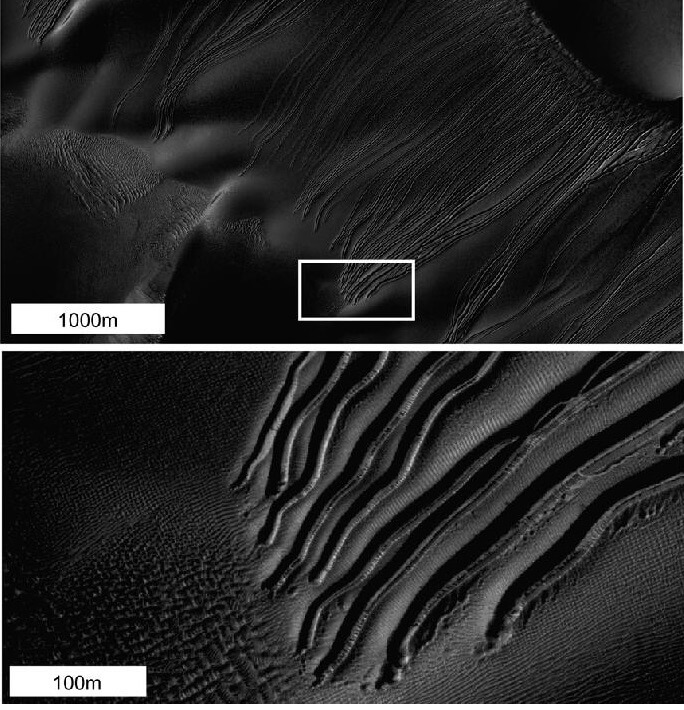Blocks of 'dry ice' that slid down the slope created a configuration full of straight grooves similar to the grooves that snowboarders make on snowy slopes on Earth. These channels form in early spring when the frozen dry ice takes off

NASA researchers estimate that frozen blocks of carbon dioxide - a substance also known as 'dry ice' - could have slid down the slopes of volcanic dunes while floating above the sand as if on miniature air cushions. On their way they plow furrows in the sand.
"I've always dreamed of going to Mars," says Serena Diniega, a planetary scientist at NASA's Jet Propulsion Laboratory (JPL) in Pasadena, California and the principal investigator of a paper that appeared in the online edition of the journal Icarus. "Now my dream is to snowboard down a sandy hill from a sandy beach on blocks of dry ice."
The researchers concluded that the process could explain one of the most enigmatic types of channels seen in sand dunes on Mars by examining images taken by NASA's MARS RECONNAISSANCE ORBITER (MRO) spacecraft and conducting experiments on dunes in Utah and California.
The straight channels, as they were called due to their shape, had a stable width of several meters and raised banks on their sides. Unlike channels formed by water flow on Earth, and possibly elsewhere on Mars, they do not end in an alluvial fan. Instead, many of them end up in small pits at the bottom of the hill.
"In the case of normal flow, the water carries with it sediments down the hill, and the material that erodes up is carried to the bottom and spreads like a fan" says Diniega. "In the straight channels, materials are not transported from one place to another, but only a groove is created under the dry ice going down the slope and the material that was there is pushed to the sides."
Images taken by the High Resolution Imaging Spectroradiometer (HIRISE) on the MRO spacecraft showed sand dunes with direct channels covered by carbon dioxide ice during the Reddish winter. And they found that the straight channels are very common in dunes that spent the Martian winter covered in dry ice (as we know, carbon dioxide is the main component of the Martian atmosphere).
By comparing 'before' and 'after' photos in different seasons, the researchers determined that these grooves were formed in early spring. In some of the photos, bright objects in the channels were also photographed.
The scientists speculate that these bright objects are pieces of dry ice that broke off and fell from higher areas. According to the new hypothesis, the channels and the pits at the bottom, were formed as a result of blocks of dry ice that took off and turned directly into gas after they stopped moving.
"Straight channels do not look like other channels on Earth or even on Mars. These processes do not occur on Earth, Diniega says. "Clumps of dry ice do not naturally form on Earth. They need to be produced in a special factory."
Indeed, this is what Candace Hansen, from the Planetary Science Institute in Tucson, Arizona, has done, studying additional effects of the seasonal dry ice blocks on Mars such as spider-like formations that result from the explosion of carbon dioxide gas trapped under a layer of dry ice when the bottom of the layer thaws (or rather takes off) in the spring. She suspects that the dry ice has a role in creating the straight channels. To test this, she bought blocks of dry ice at the supermarket and slid them down sand dunes. In several experiments she conducted, she saw that the carbon dioxide from the rising ice formed a lubricating layer under the block and pushed sand aside like little dams as the block slid down. The process was repeated on a variety of slopes, even on not particularly steep slopes.
The experiment conducted in the western US deserts did not simulate the temperatures and air pressure on Mars, but was only used to evaluate the ability of dry ice to act in a similar way at the beginning of spring on Mars, the period when the straight channels are formed.
Although water ice can also rise directly to a gaseous state under the conditions prevailing on Mars, it will remain frozen at the temperatures where these channels are formed, according to the researchers' calculations.
"The MRO spacecraft showed that Mars is a very active planet," said Hansen. "Some of the processes we see on Mars are similar to processes that also occur on Earth, so this particular process is unique to Mars."
JPL video showing how the dry ice slides down the slope and creates these furrows.

One response
Sounds like a good idea for a new adventure sport here, in DHA.
Such a ski-sand site will also not be limited to a short ski season, but will be able to operate all year round.
All that is needed is a center for producing solid air near the site, which in my opinion is not a very big challenge.